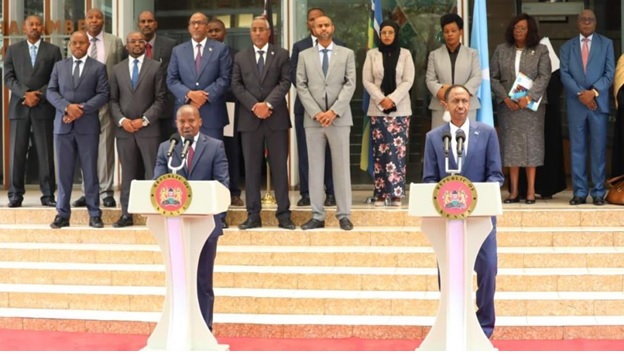
Kenya and Somalia on Monday agreed to re-open three border points amid a cloud of uncertainty on whether the benefits from increased trade and movement of people will outweigh insecurity risks.
The re-opening of the three border points—which had been shut for more than a decade due to insecurity posed by the Somalia-based terrorist group Al Shabaab—is expected to boost the flow of people and capital between Kenya and Somalia.about:blank
For the free movement of goods to resume, the agreement is subject to approval by Ethiopia and the United Kingdom, the two other countries that have been involved in the talks.
“It has been agreed that this project will proceed subject to the three partner states, Kenya, Somalia and Ethiopia, sitting down together with the UK to agree on the action plan and the detailed activities,” said Kenya’s Interior Cabinet Secretary Kithure Kindiki.
The three border points include Mandera/Belet Hawo (Belethawa), Liboi-Harhar/Dhobley and Kiunga/Ras Kamboni after more than a decade of closure.
The closure of the border points between Kenya and Somalia started in 2011 by the administration of the late President Mwai Kibaki following a spate of attacks from Al Shabaab.
Kibaki’s successor, President Uhuru Kenyatta, would tighten the closure in 2019, by banning cross-border trade between the two countries in areas such as Kiunga in Lamu County, following increased attacks by Al Shabaab in the coastal county.
These developments affected trade between the two countries, with Kenya’s exports to Somalia dropping from a high of Sh19.7 billion in 2017 to Sh11.8 billion in 2019, according to official statistics.
Reports from the Kenya National Bureau of Statistics (KNBS) show that exports from Kenya to Somalia—which includes mostly rolled tobacco, potatoes, onions, lettuce, tomatoes, tea, soap and malt extract—increased to Sh15.3 billion last year.
Imports from Somalia have also been going down from Sh954,489,000 in 2018 to Sh99,152,000 last year, which means the closure of the border points negatively impacted the trade between the two countries.
The banning of cross-border trade was also aimed at addressing the smuggling menace, with Somalia being flagged as a conduit for products such as illegal sugar.
However, some analysts have argued it is the closure of official entry points that led to the illegal flow of people, weapons and contraband across the borders.
Kenya and Somalia are also yet to resolve their maritime difference after Mogadishu demanded a review of the maritime boundary in what could alter the ocean territory for both countries.
The Hague-based International Court of Justice ruled in favour of Somalia, though Kenya did not accept the verdict.
Dr Kennedy Manyala, an economist, noted that if the agreement is not well structured, there could be an increase in cases of smuggling.
“If the goods from Somalia are not properly registered or regulated, the other East Africa members could make noise. Because they will not be sure whether some of the goods have been classified as locally manufactured to cross the borders,” said Manyala.
Professor Kindiki had a meeting with his Somalia counterpart, Dr Mohamed Ahmed Sheikh Ali.
In 2011, the administration of the late President Mwai Kibaki closed these border points citing security threats from the Somalia-based terrorist outfit Al Shabaab.
This year, Kenya invaded southern Somalia in Operation Linda Nchi following kidnappings claimed by the militant group.
However, the closure hampered trade and the movement of people between the two neighbouring countries.
Refugees from Somalia to Kenya have also been increasing, touching a high of 288,648 last year from 257,318.
Most of the refugees in Kenya are from the war-torn country, followed by South Sudan and DR Congo.
In April 2014, Al-Shabaab militants killed 148 people at Garissa University College. The fifteen-hour siege, in which gunmen held more than seven hundred students hostage, overtakes the 2013 mall raid as the group’s deadliest attack in the country.
As a result, the administration of President Kenyatta directed the closure of the Daadab refugee camp, arguing that they were terrorist cells.
Source: Business Daily


Leave a Reply